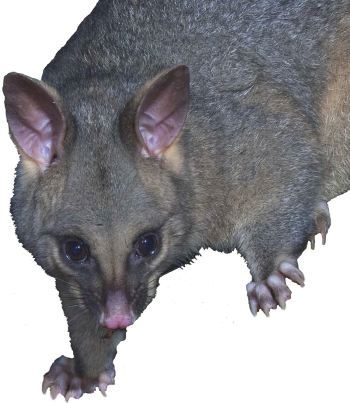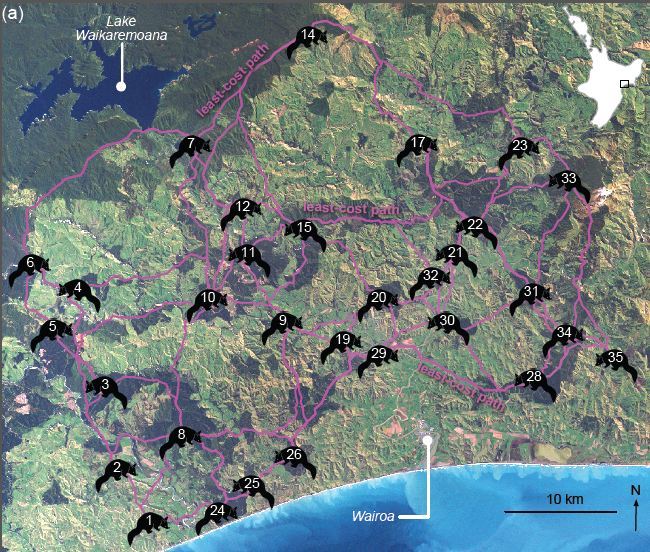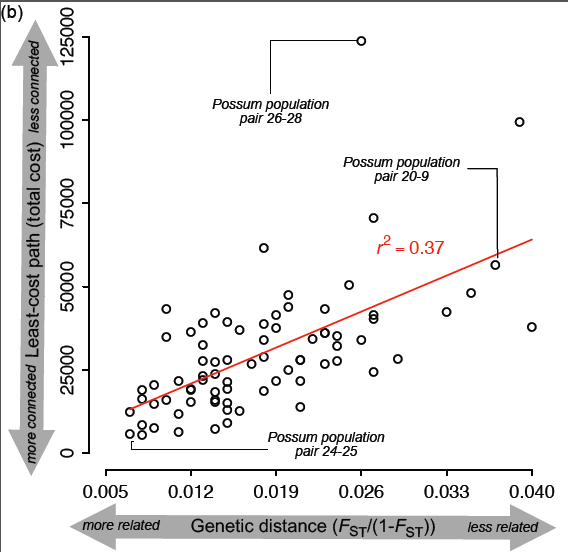
The landscape costs of brushtail possum dispersal
Thomas Etherington, School of Environment
The brushtail possum is a notorious invasive species in New Zealand.
Dispersal is a key issue for possum management as it results in the spread of bovine tuberculosis and recolonisation of conservation areas. Landscape features will act to limit dispersal by exerting costs through energetic expenditure, behavioural aversion, and mortality risk. An understanding of how these landscape costs influence dispersal is important for large-scale pest suppression programs as they must take into account the potential for possums to disperse back into an area under management.
Landscape genetics data is being used to identify the costs imposed on possum dispersal by landscape features. The assumption used is that possums that are more closely related are likely to be separated by lower landscape costs as possums must be successfully dispersing between those locations in order to transfer their genetic information. The costs associated with different landscape features is being determined by analysing the landscape genetics data using a geographic information system (GIS) approach called least-cost modelling. Least-cost modelling can find least-cost pathways between pairs of locations that represent the most efficient route that balances the distance travelled and the landscape costs traversed. An appropriate set of landscape costs would produce least-cost paths that would explain a large amount of the variation in genetic distances.

Figure 1: The brushtail possum (© Nga Manu images)
Analysing landscape scenarios
In order to apply this approach a large number of landscape scenarios consisting of different combinations of landscape features and different sets of costs values needs to be analysed. However, to calculate least-cost paths between possum sampling locations for a single landscape scenario takes on average nearly an hour to process on a desktop computer. Therefore, using a desktop computing approach would seriously limit the number of landscape scenarios that could be analysed. With help from staff at the NeSI, the Python code developed to analyse a landscape scenario was modified such that a single shell script could be used to automatically create and submit a large number of landscape scenarios to the Pan cluster for least-cost path analysis. NetworkX, GDAL, SciPy and NumPy software extensions formed a critical part of the workflow. The result of this was that 47,000 different landscape scenarios could usually be processed within 1–2 days depending on the level of activity on the cluster rather than 5 years on a desktop! Essentially, this research could not be conducted to an international standard without the resources and support provided by the NeSI.
Preliminary results suggest that large improvements in understanding the dispersal of possums across landscapes can be achieved by accounting for the costs associated with landscape features (Figures 2a and 2b). The analyses indicate that the main factors controlling possum dispersal are the size of major rivers followed by the absence of tree and scrub landcover.
Once the analyses are completed, GIS maps that represent the landscape in terms of costs to possum dispersal will be produced. These cost maps will then be used as inputs to further GIS analyses that will enable large- scale pest suppression programs to tailor management based on whether parts of a landscape are more or less isolated, or are more or less likely to act as dispersal pathways.

Figure 2a: Preliminary results from the least-cost modelling have identified pathways that represent the most efficient route across the landscape between neighbouring possum sampling locations.

Figure 2b: A correlation between genetic distance and least-cost path total cost, where each point represents a neighbouring possum population pair. If the landscape does affect dispersal then possum sampling locations that are more connected should be more related, and possum sampling locations that are less connected should be less related. The amount of variation in the genetic distances that can be explained by the least-cost paths suggest that landscape features do affect possum dispersal.
See more case study projects

Our Voices: using innovative techniques to collect, analyse and amplify the lived experiences of young people in Aotearoa

Painting the brain: multiplexed tissue labelling of human brain tissue to facilitate discoveries in neuroanatomy

Detecting anomalous matches in professional sports: a novel approach using advanced anomaly detection techniques

Benefits of linking routine medical records to the GUiNZ longitudinal birth cohort: Childhood injury predictors

Using a virtual machine-based machine learning algorithm to obtain comprehensive behavioural information in an in vivo Alzheimer’s disease model

Mapping livability: the “15-minute city” concept for car-dependent districts in Auckland, New Zealand

Travelling Heads – Measuring Reproducibility and Repeatability of Magnetic Resonance Imaging in Dementia

Novel Subject-Specific Method of Visualising Group Differences from Multiple DTI Metrics without Averaging

Re-assess urban spaces under COVID-19 impact: sensing Auckland social ‘hotspots’ with mobile location data

Aotearoa New Zealand’s changing coastline – Resilience to Nature’s Challenges (National Science Challenge)

Proteins under a computational microscope: designing in-silico strategies to understand and develop molecular functionalities in Life Sciences and Engineering

Coastal image classification and nalysis based on convolutional neural betworks and pattern recognition

Determinants of translation efficiency in the evolutionarily-divergent protist Trichomonas vaginalis

Measuring impact of entrepreneurship activities on students’ mindset, capabilities and entrepreneurial intentions

Using Zebra Finch data and deep learning classification to identify individual bird calls from audio recordings

Automated measurement of intracranial cerebrospinal fluid volume and outcome after endovascular thrombectomy for ischemic stroke

Using simple models to explore complex dynamics: A case study of macomona liliana (wedge-shell) and nutrient variations

Fully coupled thermo-hydro-mechanical modelling of permeability enhancement by the finite element method

Modelling dual reflux pressure swing adsorption (DR-PSA) units for gas separation in natural gas processing

Molecular phylogenetics uses genetic data to reconstruct the evolutionary history of individuals, populations or species

Wandering around the molecular landscape: embracing virtual reality as a research showcasing outreach and teaching tool
























































































































































